This one-pan vegan Spanish paella bursts with a medley of vibrant vegetables, including asparagus, zucchini, tomatoes, peas, onions, and more, for a flavor-packed dish.
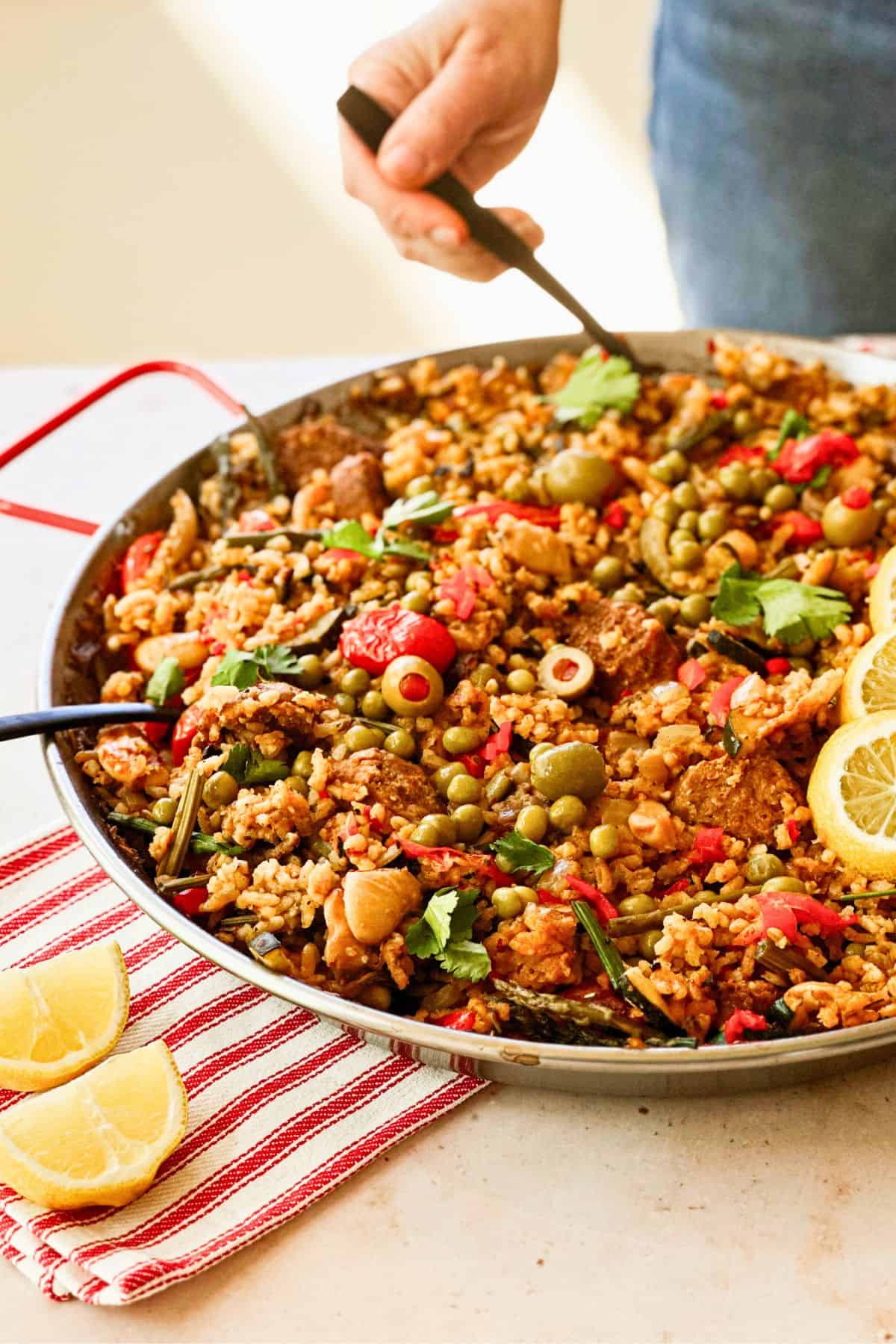
For me, the best part of paella has always been the saffron-infused rice—golden, aromatic, and loaded with flavor.
Growing up in a Cuban household with Spanish roots in Miami, paella (pronounced pie·ay·uh) was a big deal—reserved for family gatherings and any excuse to throw a party.
My mom, however, was less thrilled when I’d carefully eat around the meat, unknowingly paving my vegan path early on.
Naturally, I had to create a plant-based spin that preserves the essence of paella with rich spices, vibrant vegetables, and perfectly cooked rice.
And if you’re craving more vegetable Spanish-inspired dishes, don’t miss my Vegan Spanish Omelet (Spanish Tortilla), Creamy Cucumber Gazpacho, and Easy Watermelon Gazpacho.
Jump to:
- Is Spanish Paella Traditionally Vegan
- What is Socarrat?
- Why It's Important Not to Stir The Rice in Paella
- Do I Need a Special Pan?
- Ingredients
- What is the Best Rice For Paella?
- How To Make Vegan Spanish Paella
- Top Tips
- Trouble Shooting
- How to Serve Vegan Spanish Paella
- Serving Suggestions
- Vegan Paella FAQS
- More Spanish and Cuban-Inspired Recipes
- Vegan Spanish Paella
- Comments
Is Spanish Paella Traditionally Vegan
No, it's not.
Hailing from the Valencia region in Spain, rice plays a starring role in Valenciana paella with a traditional ensemble cast of chicken, pork, rabbit, and snails, along with a colorful crew of green beans, white beans, tomatoes, and sometimes artichokes.
Recipes vary from all over Spain, which could make your head spin. Growing up in Miami, I had a lot of paella recipes too, including those with seafood such as shrimp, scallops, and clams, as well as meats like chorizo. I've also had it with oysters, crabmeat, and lobster tails, turning it into a culinary extravaganza.
What is Socarrat?
Now, if you're starting your paella journey, and there is only one thing you learn from this post, learn the term socarrat. Say "soccer rat" with the zestiest Spanish accent you can muster - SO-CAR-RAT - now you won't forget it. Without socarrat, the Spanish feel it's just...well, a simple rice dish.
Socarrat forms on the bottom of the pan when the broth evaporates, allowing the rice to fry, crisp up, and caramelize - not burnt, just caramelized. It is the ultimate prize for any paella cook and the mark of a good paella. Trust me, once you've experienced the joy of socarrat, you'll crisp up the pan bottoms with purpose.
Which leads me to - Why it's important not to stir the rice in Spanish paella.
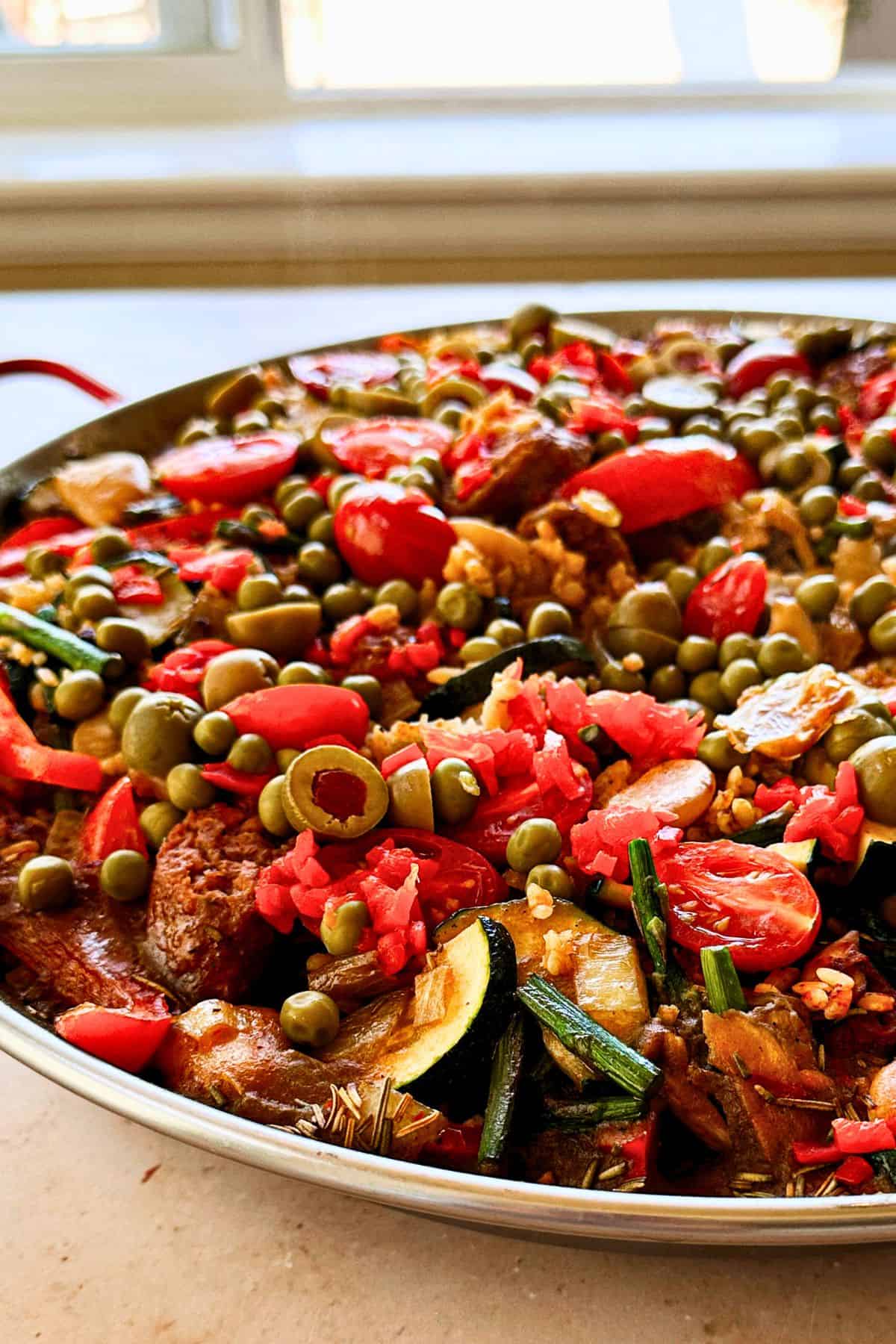
Why It's Important Not to Stir The Rice in Paella
In the world of paella, there are not too many rules except one hard fast rule: hands off the rice!
By resisting the urge to stir, you allow the rice to form that coveted socarrat.
Stirring disrupts this process, releasing tons of starch and leading to a loss of firm texture, as well as missing out on the signature caramelization that makes paella truly special. So keep that spoon at bay and let the magic happen! No touchie.
Do I Need a Special Pan?
No you don't, but...
In traditional paella-making, the magic happens over an open flame in a wide, shallow pan known as a "paellera." The traditional paella pan is spacious with a shallow structure. The wide surface is important as it ensures every grain of rice gets its moment in the sun, basking equally at the pan's bottom for that perfect socarrat.
However, don't worry if you don’t have one of these paella pans. Any large pan will work for making the paella.
However, for a better chance of achieving socarrat, use thin aluminum or stainless steel.
If all you have is cast iron, I've achieved a decent socarrat in an enameled cast iron pan. Let me know in the comments if you successfully use a regular cast iron.
For this post and video, I used a 13-inch paella pan and filled it to the rim to make this recipe. So, make sure to use your largest pan.
Ingredients
Here's everything you'll need for this vegan Spanish Paella. See the recipe for details.
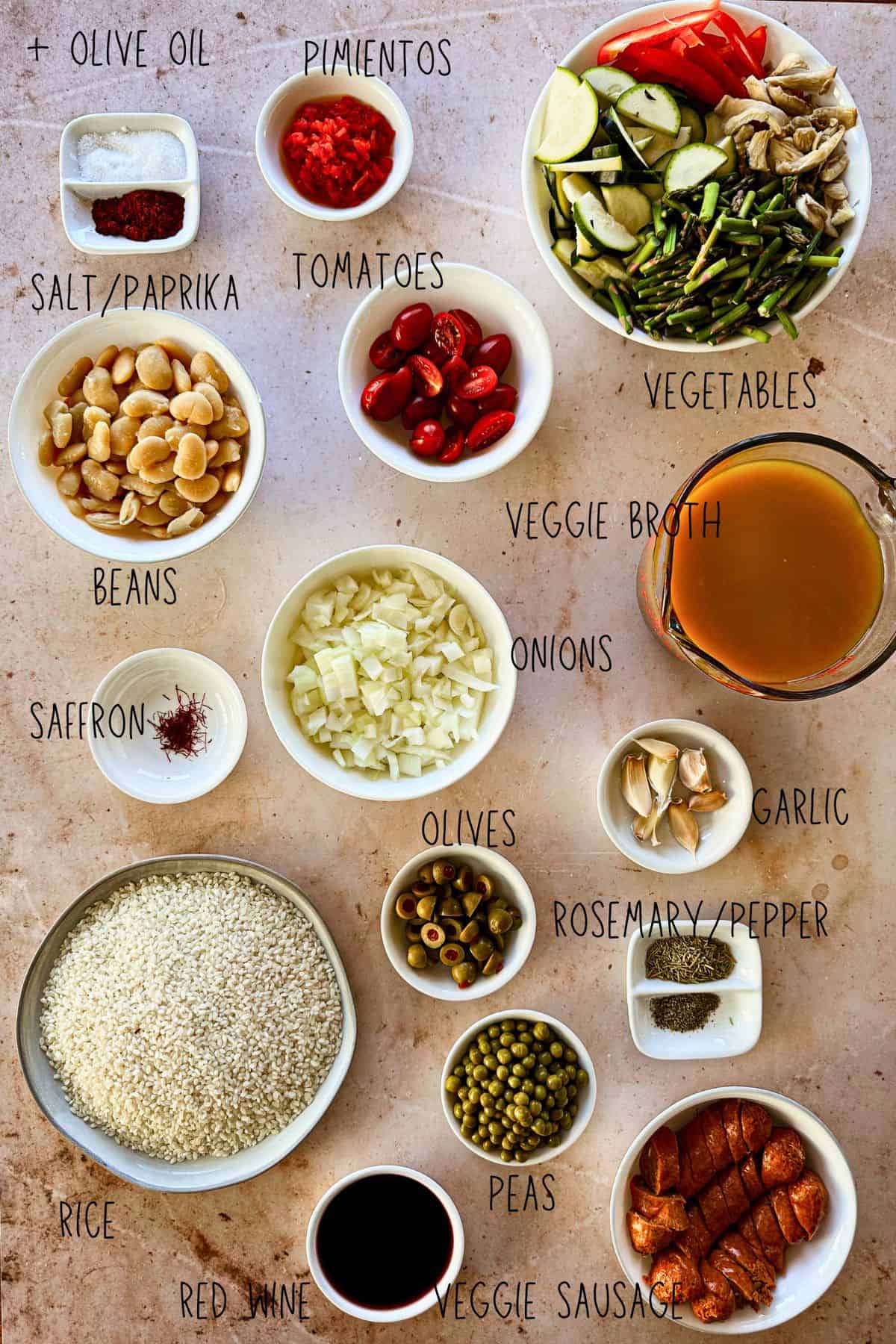
- Sausage: I use Beyond Meat sausage because it browns, caramelizes, and leaves flavorful oil that helps create socarrat. If using other plant-based options like soy curls or Daring Chicken, make sure there’s some fat in the pan.
- Spanish manzanilla olives and pimientos: Not traditional, but I love adding Spanish manzanilla olives and pimientos for flavor and color. Check labels—some olives are stuffed with anchovies. Find them in the international or olive section of most stores.
- Wine: Wine adds depth to this dish—red or white works. While it’s not traditionally used in paella, it’s often enjoyed alongside. Skip it if you prefer, and it’ll still be delicious.
- Smoked paprika: Smoked paprika works great, but for a more authentic flavor, try Spanish pimentón for a nuanced, smoky taste. It’s easy to find in specialty stores or online.
- Salt: You might think we're running a salt mine here with the amount we use in this recipe, but trust me, it's all about cranking those flavors. Of course, if you're more of a 'lightly seasoned' kind of chef, feel free to dial it back.
- Vegetables: Swap the veggies for your favorites—just stick to the same volume for the best results.
- Saffron: Known as the world’s most expensive spice, saffron is sold in small, affordable quantities. A little goes a long way, adding a rich, traditional flavor. Look for it in stores like Whole Foods or order it online.
What is the Best Rice For Paella?
For a paella that's as close to the original as vegan cuisine gets, picking the right rice is crucial, hence, the question is addressed in its own section of this post.
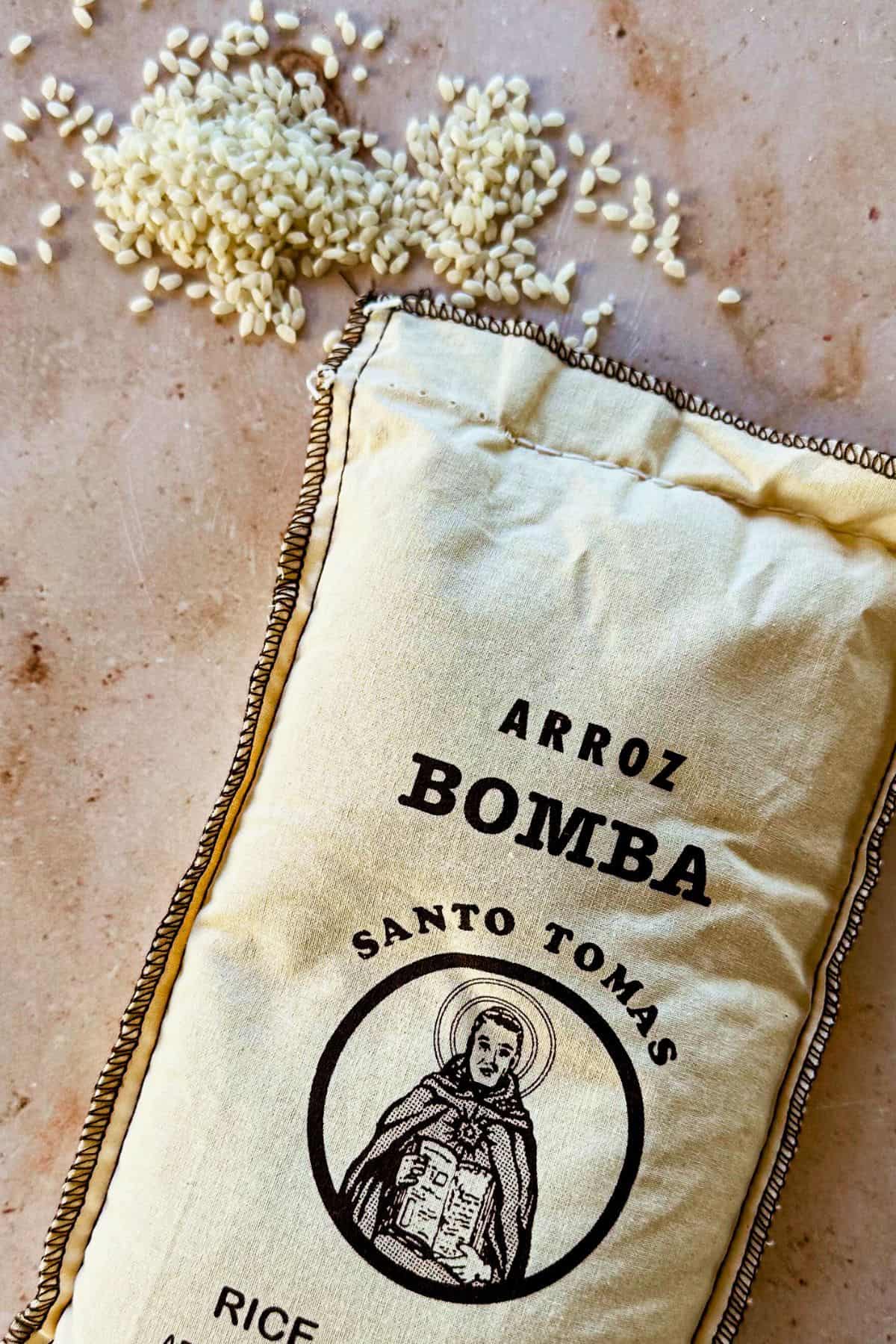
Stick with short-grain rice, such as bomba or calasparra, which soak up broth without becoming mushy. This recipe’s ratios are designed for these varieties.
Can’t find them? Arborio works well, but avoid stirring to prevent a risotto texture and use a 2:1 broth-to-rice ratio.
Calrose (medium grain) is another excellent option, widely available, with a 2.5:1 ratio.
If you’re desperate, parboiled rice (long grain) can work, but it’s less traditional. Go with a 2 ¼:1 ratio and expect a different texture.
Swapping rice may require adjusting ratios and cook times, so keep extra broth on hand to adjust as needed.
How To Make Vegan Spanish Paella
Once you master the skill of making socarrat, this is an easy dish to prepare any night of the week with any seasonal vegetables you want to include. It's also fancy enough for guests, thanks to its attractive presentation. See the printable recipe card for details.
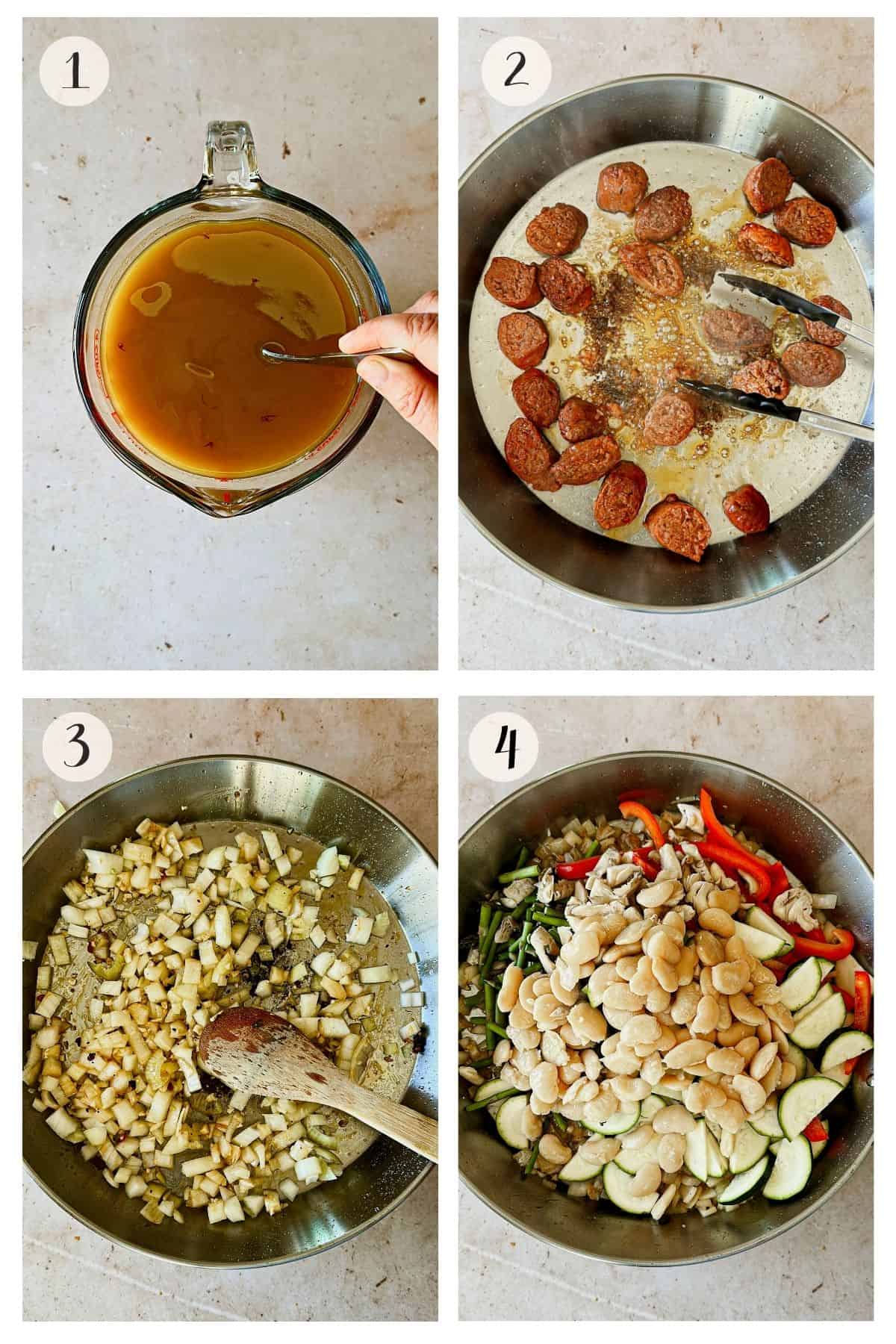
Step 1: Steep the saffron threads in 5 cups of hot vegetable stock for later use. You can microwave the broth or boil it on the stove.
Step 2: In a large skillet over medium heat, brown the sliced sausages in oil for 5 minutes. Remove and set aside, leaving the flavored oil behind.
Step 3: Sauté diced onions and garlic with a pinch of salt until translucent and fragrant.
Step 4: Add red peppers, zucchini, asparagus, mushrooms, and beans, and cook for 5-7 minutes, until the veggies have reduced slightly in size. Then, add the red wine, if using, to deglaze the pan.
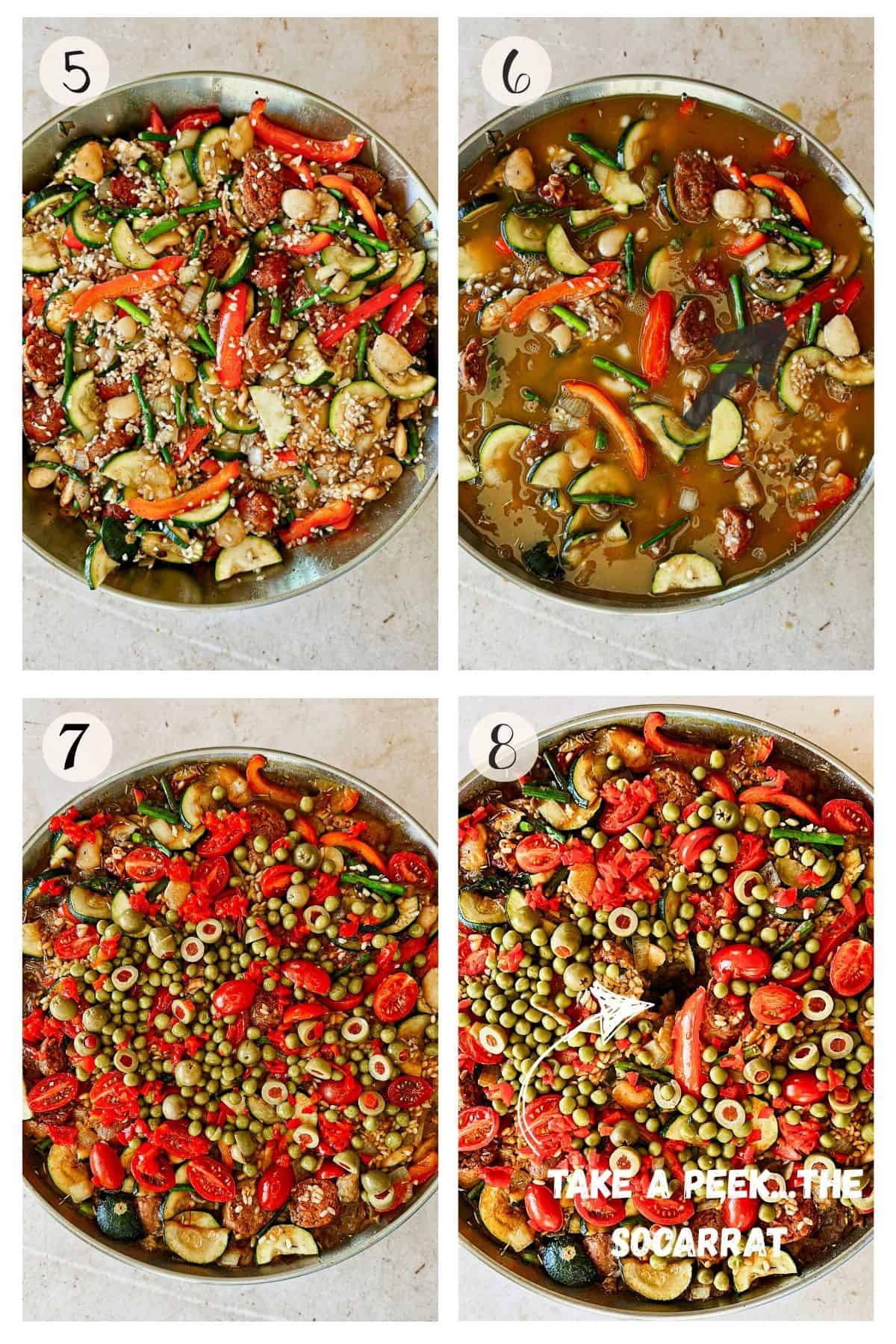
Step 5: Stir in rice, smoked paprika, rosemary, salt, and pepper, toasting rice briefly - for about 2 minutes. If using sprigs of rosemary, nestle them on top.
Step 6: Add the sausage back to the pan, then pour in the saffron broth. Do not stir, but gently shake the pan to distribute the ingredients evenly. Cook on medium-high heat for 15-18 minutes until most of the water is absorbed.
Step 7: Scatter the cherry tomatoes over the pan, gently pressing them down. Then, add the peas, olives, and pimientos (if using). Partially cover and cook on medium heat for 10 minutes to warm the toppings, steam the top layer of rice, and form the socarrat.
Step 8: If the top rice isn’t soft, add ½ cup of broth and cook for a few more minutes, until you hear sizzling. Check for socarrat by peeking at the bottom; if it’s not there, cook for an additional 2 minutes on medium-high heat. Serve hot with lemon wedges.
Top Tips
Even though this dish is still delicious without the socarrat, we want to aim for it and make Spain proud. It's all about the rice-to-liquid ratio, pan, heat, and timing. Here are a few tips:
- Get the liquid-to-rice ratio right. Too much liquid or insufficient ratios will not get you the coveted socarrat.
- After adding the broth, pretend the dish is a sleeping baby. Just let it lie undisturbed on a cozy bed of heat until all is said and done.
- Manage the heat. Most of the dish is cooked on medium-high heat. Then it is lowered to ensure you don't get burnt rice, but a nice caramelized rice.
- Channeling your inner culinary detective is key to nabbing that socarrat. Engage your senses: Watch the paella for signs of that golden crust by taking a peek at the bottom, listen for the telltale sizzle that whispers, "Turn the heat down, chef!" and let your nose lead the way to the nutty aroma of success.
- Ditch the lid. Your paella needs to breathe! Keeping it open ensures the rice hits that perfect al dente and dry finish. You want a dry and flavorful paella, not a wet and soggy one. Use the lid or aluminum foil when heating the toppings and caramelizing the bottom.
- I sometimes add a little oil to the pan when heating the toppings. It will drizzle down to the bottom and help form the socarrat.
- Don't wash the rice. The dish needs starch.
- When saffron is unavailable to you, use bijol (look away, paella purists - found in the Latin section of the store). It can provide a similar vibrant yellow/orange color of saffron, but be warned, it does not offer the same flavor that takes your paella from "yummy" to "¡Ay, caramba!". Turmeric can also audition for the role of color booster, but just so you know, it ad-libs on the flavor. If you're cool with major improv in your dish, go for it.
Confidence Tip
Don't get discouraged. I burnt the pan bottom when making this post and had to remake the dish the next day - and I've made this dozens of times! My mistake is often my impatience, and I turn up the heat too high in the end.

Trouble Shooting
- If the rice at the top of your paella is too hard after the water has reduced, just pour in a little more broth (about half a cup should do the trick), slap a lid or aluminum on it, and let the rice steam away in its own little sauna for 7-10 minutes.
- On the other hand, if the rice turns out mushy, it has been overcooked, and you've stumbled upon my secret talent for stating the obvious. You can't correct mushy rice, but to avoid this issue in the future, ensure you're using the correct water-to-rice ratio for the type of rice in your recipe, and don't stir it once it's in the broth.
How to Serve Vegan Spanish Paella
- When it's time to serve up your vegan paella, you can keep it classic by serving it family-style straight from the pan, with everyone gathered around the table digging into the delicious rice dish together.
- However, individual servings can also be plated and garnished with fresh herbs like cilantro or parsley. Lemon slices also make a nice presentation. Just make sure to scrape the bottom of the pan and give everyone some socarrat! You can see it in the picture below throughout the dish.
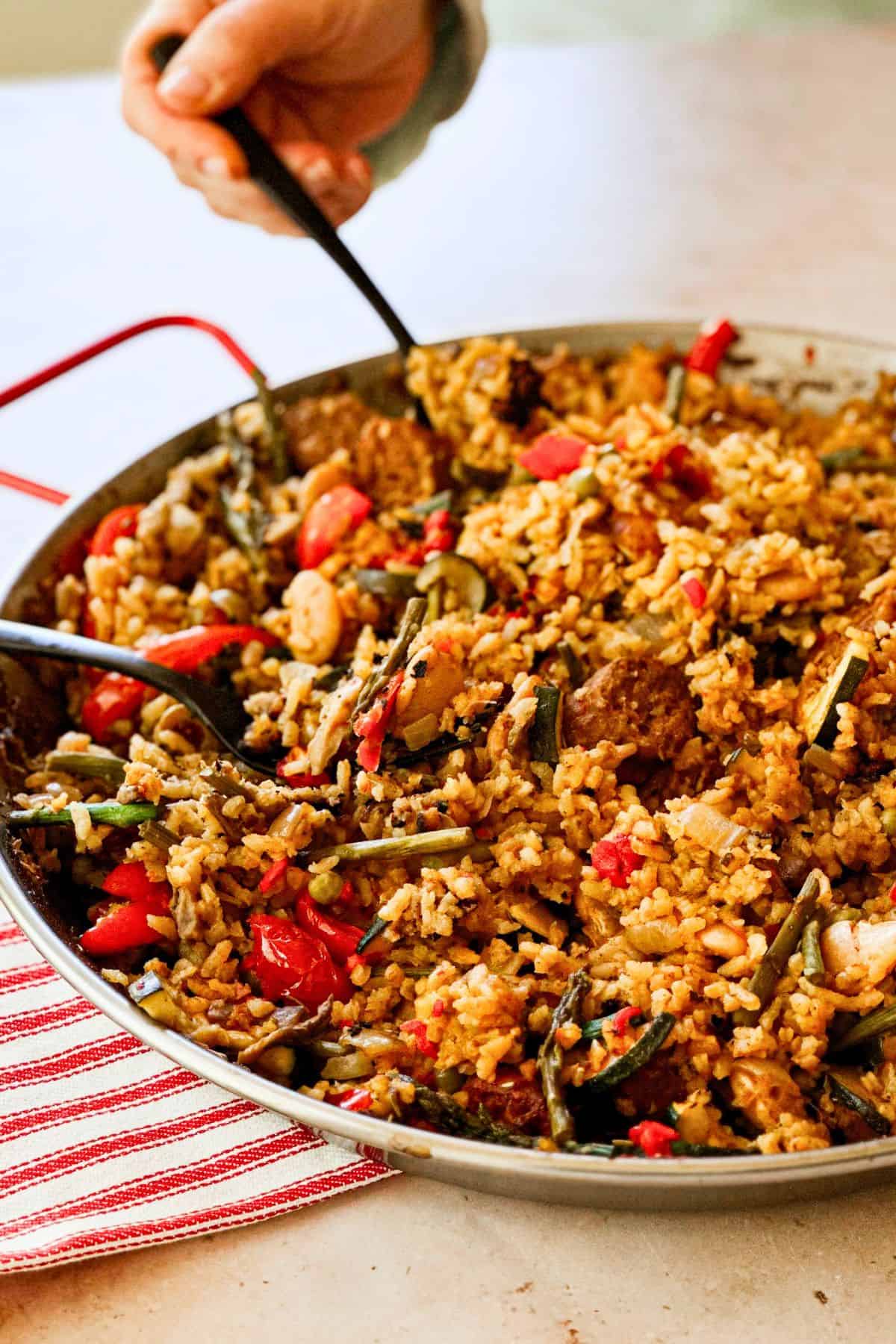
Serving Suggestions
Consider serving the paella with some traditional Spanish accompaniments and sides. Here are a few suggestions:
- In some parts of Spain, paella is enjoyed with Easy No Egg Aioli Recipe, a garlic-infused mayonnaise that complements its savory flavors (especially with seafood varieties).
- A simple mixed green salad with a tangy vinaigrette, like Classic French Salad Dressing, can provide a refreshing contrast to the rich and savory flavors of the paella.
- Pan con Tomate (Bread with Tomato): Drizzle bread and a slice of tomato with olive oil and sprinkle with salt. It's a delicious way to start the meal or to enjoy alongside the paella.
- My version of a vegan Vegan Spanish Omelet (Spanish Tortilla), sliced into wedges, is a delicious appetizer to serve before the meal.
Vegan Paella FAQS
Yes, you can prepare vegan paella ahead of time and reheat it before serving. However, remember that the rice's texture may dry up upon reheating. To maintain the best texture, store the paella in an airtight container in the refrigerator for no more than a few days. Reheat it gently on the stovetop or in the microwave.
Change out the vegetables. Just keep the same ratios of veggies to rice for the best results. Some ideas for swaps include yellow squash, artichokes, green beans, and different mushrooms.
No. You can use any vegan sausage you want or leave it out. However, I find that Beyond Meat sausage releases oil and flavor into the pan, enhancing the sautéed onions, garlic, and veggies with an extra burst of flavor. The oil will also help you achieve a better socarrat.
No, I do not recommend using brown rice. Since brown rice is a bit of a slowpoke in soaking up liquid, your veggies might end up more on the 'well-done' side. If brown rice is a must-have for you, consider giving it a head start: cook it according to the package's water-to-rice ratios then use the same technique in the recipe for creating the socarrat. Meanwhile, give your veggies a quick sauté in a separate pan and mix them into the rice before serving. This way, everything comes out just right – the rice perfectly cooked and the veggies crisp, not mushy.
More Spanish and Cuban-Inspired Recipes
Got a minute? I'd love for you to dive into the comments and rate this Vegan Spanish Paella recipe. Your feedback is invaluable—did you love it? Did you make any fun twists? Let me know how my directions worked for you so I can keep improving my recipes.
Follow me on Pinterest, Instagram, Facebook, and YouTube for inspiration.

Vegan Spanish Paella
Equipment
Ingredients
- 1 pinch saffron threads - a little less than a gram or ~1 teaspoon; sub with ¼ teaspoon ground saffron
- 5 cups vegetable broth hot
- 2 tablespoons olive oil
- 3 Beyond Meat sausages sliced*
- 1 small onion diced
- 6 cloves garlic minced
- 1 red bell pepper sliced (substitute with any color pepper)
- 1 small zucchini sliced into half-moons
- 1 cup asparagus cut into 1-inch pieces
- 3.5 ounces oyster mushrooms chopped
- 1 can butter beans or fava beans, shelled
- ⅓ cup red wine optional
- 2 cups paella rice bomba or calasparra rice
- 2 teaspoons salt
- 1 teaspoon smoked paprika
- 1 teaspoon dried rosemary or three sprigs
- ½ teaspoon pepper to taste
- 12 cherry tomatoes halved (or 1 tomato, chopped)
- ¼ cup sweet peas canned or frozen
- ¼ cup pimientos** optional
- ¼ cup Spanish manzanilla olives sliced**
- lemon wedges for serving
Instructions
- Prepare: Heat up 5 cups of hot broth using the microwave or stovetop. Crush the saffron threads gently between your fingers, mix it in the hot broth, and set aside.
- Brown: Heat olive oil on medium heat in a large pan. Add the sliced sausages and saute until lightly browned about 5 minutes. Remove with a slotted spoon and set aside. They'll release some flavorful oil, so leave that in the pan.
- Sauté: In the same pan, add diced onion and garlic with a pinch of salt and sauté until onions are translucent.
- Cook: Incorporate sliced bell peppers, zucchini, asparagus, mushrooms, and beans cooking until the vegetables start to soften and reduce slightly in size, about 5 minutes. Then add the wine if using to deglaze the pan and allow it to evaporate, about 2-3 minutes.
- Combine: Add the sausage back in. Stir in the rice, smoked paprika, rosemary, salt, and pepper. Allow the rice to toast slightly to enhance its flavor, about 2 minutes. If using rosemary sprigs, nestle them on top.
- Add: Turn up the burner to medium-high heat. Pour in the saffron-infused broth, ensuring it fully covers the rice. Gently press down any grains peeking out above the surface and give the pan a good shake to even out the contents. And remember, no stirring after this moment – let the magic happen undisturbed!
- Simmer: It should be simmering vigorously on medium-high. Let the paella cook uncovered for about 15-18 minutes or until the rice is al dente and most liquid has been absorbed. The rice should be firm but cooked through. If some of the top rice pieces are a little firm, they will continue to soften in the next step.***
- Top: Turn the heat to medium and gently scatter the sliced cherry tomatoes over the pan, nudging them down just enough so they're snugly nestled and partially submerged. Then, top the dish with peas, olives, and slivers of pimientos, and partially cover with a lid or aluminum foil. Cook for an additional 10 minutes to heat the toppings and form the socarrat.
- Check: Take a quick peek at the bottom of the pan by scooping aside a bit of rice for a glance. You're looking for a pleasant dark brown color, but not burnt. If no socarrat is in sight, up the heat for a minute or two.
- Serve: Serve the vegan paella hot, with lemon wedges on the side for squeezing over the top.




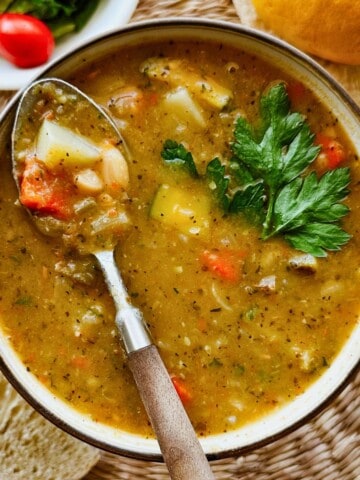
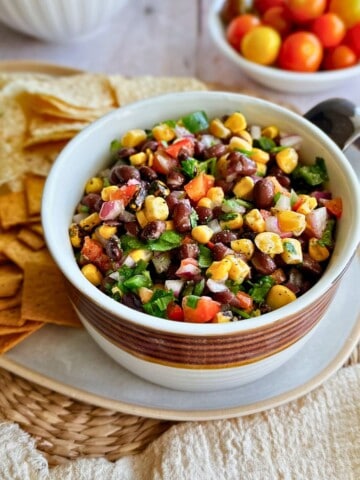

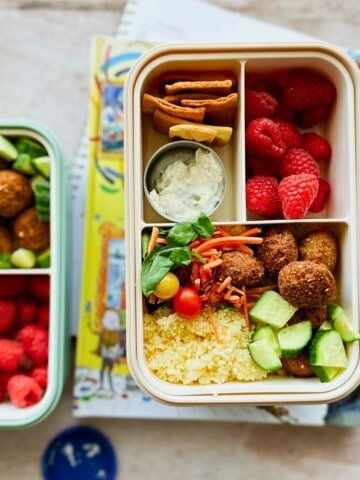
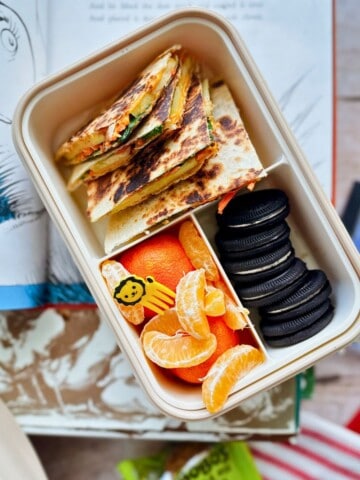
Amy says
I've always been intimidated to try making paella myself, so I really appreciate your step-by-step instructions with photos along with details about the ingredients and helpful tips!
Regi Pearce says
Ahh thanks Amy! Let me know how it goes if you try it and shoot over any questions you might have.
Rob says
This looks great! Can't wait to try it. I'll let you know how it comes out.